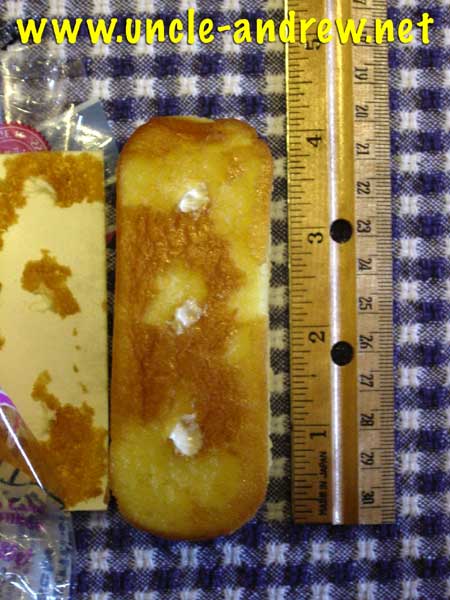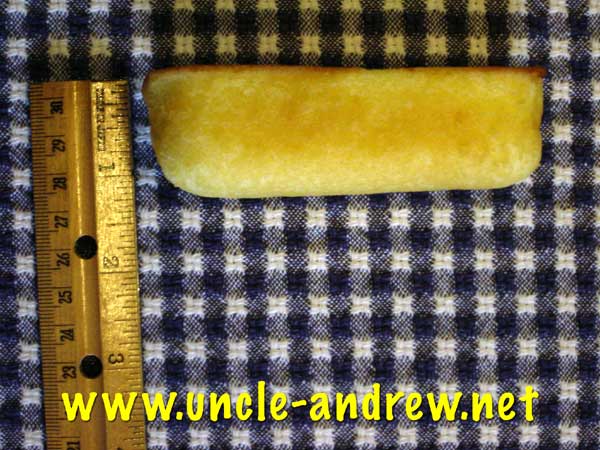Forty Minutes I’ll Never Get Back
 Uncle Andrew
Uncle Andrew
Because we did not yet have one (the chief justifcation for so many of my purchases), this weekend Margaret and I picked up a copy of Ghostbusters, the high-larious 1984 film starring Bill Murray, Dan Aykroyd and Harold Ramis. We and Shawn watched it Saturday night. The film has held up extraordinarily well (far better than, say, Caddyshack); aside from the music—which wasn’t any great shakes when the film was new, but really hasn’t stood the test of time (all those hard-stereo-panned syntho tom-toms!) it was as good a flick to watch today as it was when it was released.
This weekend, however, watching it with an older and perhaps more critical eye, I picked up on something I had not the first time ’round. In the second half of the film, Aykroyd, Ramis and co-star Ernie Hudson are standing around in the basement of the Ghostbusters’ headquarters. Ramis’ character is expressing concern regarding the recent upswing in business for the company. He holds up a Twinkie:
RAMIS: Well, let’s say this Twinkie represents the normal amount of psychokinetic energy in the New York area. According to this morning’s sample it would be a Twinkie…[considers]…35 feet long weighing approximately six hundred pounds.
AYKROYD: [Chokes on cigarette smoke, coughs]
HUDSON: That’s a big Twinkie.
RAMIS: [Takes bite out of Twinkie]
Great scene. However, the projected weight of six hundred pounds struck everyone watching that evening as sorely understated. Since I am the only one in this bunch to ever actually come in contact with a Twinkie, I took it upon myself to obtain a sample for analysis.

As you can see above and below, a Twinkie measures approximately 4 inches in length, 1.5 inches in width and 1.25 inches in height.

Since a pack of two has a net weight of 3 ounces, one may deduce that a single Twinkie weighs 1.5 ounces.

If Ramis’ theoretical Twinkie was 35 feet in length, it was proportionately 105 times the size of a standard-issue Twinkie. This would make it 420 inches long, 157.5 inches wide and 131.25 inches tall, with a volume of 8,682,187.5 cubic inches. Divided by the 7.5 cubic inches in a regular Twinkie, this would make the theoretical Twinkie some 1,157,625 (105 cubed) times larger in volume.
1.5 ounces multiplied by 1,157,625 is 1,736,437.5 ounces. Divide that by 16 and you get 108,525.34 pounds.
Now that is a big motherfucking Twinkie.
(Many thanks to Margaret for providing a second opinion—and calculation.)



October 2nd, 2005 at 4:31 pm
Ahhhh, but maybe Eagon was calculating the weight of a Twinkie in it’s foam state. As it is commonly known a Twinkie is not cooked
it is in truth the result of a chemical reaction from a “Hostess Baking foam”. So perhaps 600 pounds is the weight of the “raw”
or “Sashimi Twinkie” -Dr Shawn from the S-M-R-T think tank.
October 3rd, 2005 at 9:52 am
Another way to look at it is that Egon’s six hundred pound Twinkie is displacing about four hundred pounds of air. That’s a pretty thin foam.
October 3rd, 2005 at 11:48 am
The real question is how many fruit flies would it take to lift a Twinkie that size? 🙂
October 3rd, 2005 at 12:01 pm
Ignore Shawn’s ravings; he also subscribes to the Animal 57 theory. 😉
October 4th, 2005 at 5:33 am
While I agree with your basic order of magnitude calculation I think that such a Twinkie would weigh significantly more then your prediction. Basically, the calculation you provided does not take into account the reinforcing required for the Twinkie to hold its shape and not collapse in a deadly tidal wave of cream filling.
Further, I reject the idea that this is a space Twinkie and therefore not subject to the effects of gravity since in his original quote Ramis refers to the Twinkie’s weight and not its mass. If he had meant mass he would have described a 600 slug Twinkie, which is still wrong since a 108,525.34 lb Twinkie has a mass of 3373.07 slugs.
One outside possibility is that Ramis is referring to the buoyant weight of a sodden 35-foot Twinkie in water. A Twinkie’s sodden buoyant weight can be estimated by calculating the buoyant weight of a dry Twinkie and estimating the quantity of water the Twinkie can absorb. The buoyant weight of a 35-foot dry Twinkie is equal to its weight in air minus the weight of the water it displaces, calculated from the Twinkie’s volume and the density of water, 62.4 lb/ft^3, giving a giving a dry buoyant weight of negative 204,998.10 lb. Now all we have to do is estimate the volume of water that can be absorbed by a 35 foot Twinkie.
Thinking about this, approximately one-quarter to one-third of the Twinkie’s volume is composed of cream filling which I have heard consists of a mixture of whipped shortening and sugar. Since shortening is oil we will assume that the whipped filling repels water so the volume available for water absorption is limited the remaining sponge cake or approximately 3768.31 to 3349.60 cubic feet. Of this remaining volume, water should only displace air voids and not the solid component of the cake. Assuming 90% of the cakes volume is air, this provides a buoyant weight for our sodden Twinkie of between -16,884.04 lb and 6,630.22 lb depending on the amount of whipped filling. Additionally by reversing our calculation we can conclude that a 35-foot Twinkie whose volume is 27.13% cream filling will have a buoyant weight of 600 lb.
Of course these calculations are only approximate and additional tests should be performed to confirm estimates of the porosity of the sponge cake and the proportion of the Twinkie’s volume consisting of whipped filling. However, since a Twinkie measured in this way will be supported on all sides by hydrostatic pressure the reinforcing, mentioned earlier, should not be necessary. So if Ramis is describing the weight of a 35-foot Twinkie that is self supporting due to its immersion in water than his weight estimate is within the range of possibility.
October 4th, 2005 at 7:35 am
Wow, there’s another forty minutes I’ll never get back! 😕
We definitely need to invite you to our next Thanksgiving dinner, Joe; you would have been an invaluable addition to the “how many fruit flies would it take to lift a human being” debate we hashed over a few years back, referenced above by Curt.
October 4th, 2005 at 11:43 am
For some reason I am compelled to point out that, since the “cake” and filling of the super Twinkie are both less dense than water, its buoyant weight will either be negative (if it is tethered to the bottom) or zero (if it is free to float.) The only way to get a net weight of 600 pounds would be to place it in shallow water of the correct depth to displace 107,925 pounds – so a little less than four feet if the “cake” remains filled with air (rather like a beached whale), up to a little over ten feet if it completely floods with water (think of a giant Twinkieberg run hard aground.)
Fortunately for the project, I can find no evidence that Twinkies are water soluble.
October 4th, 2005 at 11:59 am
I knew that a bunch of my more empirically-minded friends would chime in on this one….you all did me proud. And perhaps a little worried.
And I truly love the term “Twinkieberg”. Like the one that sank the Dietanic! 😀
October 4th, 2005 at 1:54 pm
Purely on the grounds that I haven’t been geeky enough yet, I shall share the realization that while a normal Twinkie has a negative buoyant weight in water, Egon’s 600 pound Twinkie would actually have a negative buoyant weight in gaseous carbon dioxide. You could lift it off the ground by packing the area around it with dry ice, as long as it were in a depression of some sort to keep the CO2 from flowing away.
And, since I suspect that the origin of this Twinkie fascination might be diet-related, it’s worth noting that if one were to scale this freak of a confectioner’s imagination back down to the size of an actual Twinkie, it would have about 1/40 of a Calorie. It would take about 3,000 of them to count as a Point on the Weight Watchers system.
This has been the day in numbers. Thank you and good night.
October 5th, 2005 at 12:24 am
I would be happy to comment on the issue of using fruit flies for mass lifting but this may be a simple case of real world engineering limitations overcoming hypotheticals. Specifically, I know from personal experience that a honeybee cannot lift much more than two feet of cotton thread. Scaling this to fruit flies, it seems likely that any tether long enough to be of use for lifting and light enough that some of the flies thrust actually gets transferred to the target mass would have to be composed of some extremely light weight materials, resulting in a tensile strengths so small that the flies thrust would be enough to cause the tether to break.
Again additional research would be required to determine a fruit flies lifting capacity and the tensile strengths of materials such as spiders web, caterpillar silk and threads made from ultra fine Kevlar or nanotubes.